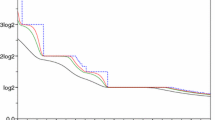Abstract
As was done by Sinclair and Ross (1969(, we consider a cellular population that consists initially (at time zero) ofN 0 newborn cells, all with the same volumev o. It is assumed that the occurrence of cell division is determined only by a cell’s age, and not by its volume. The frequency function of interdivision times, τ, is denoted byf(τ). If cell death is negligible, the expected number of cells,N(t), will increase according to the laws of a simple age-dependent branching process. The expression forN(t) is obtained as a sum over all generations; thevth term of this sum, in turn, is a multiple convolution integral, reflecting the life history ofvth generation cells (i.e., the lengths of thev successive interdivision periods plus the age of the cell at timet). Assuming that cell volume is a given function of cell age, e.g., linear or exponential, and that cellular volume is exactly halved at each division, it is possible to calculate the volume of a cell with a given life history, and thus the average cellular volume of the whole population as a function of time. If at time zero the volumes differ from cell to cell, the final equation must be modified by averaging over initial volumes. In the case of linear volume increase with age, a very simple asymptotic expression is found for the average cellular volume ast→∞. The case of exponential volume increase with age also leads to a simple asymptotic formula, but the resulting volume distribution is unstable.
The mean cellular volume at birth and the second moment of the volume distribution can be calculated in a similar manner.
Similar content being viewed by others
Literature
Anderson, E. C., G. I. Bell, D. F. Petersen and R. A. Tobey. 1969. “Cell Growth and Division, IV. Determination of Volume Growth Rate and Division Probability.”Biophys. J.,9, 246–263.
Bell, G. I. 1968. “Cell Growth and Division, III. Conditions for Balanced Exponential Growth in a Mathematical Model.”,8, 431–444.
and E. C. Anderson. 1967. “Cell Growth and Division, I. A Mathematical Model with Applications to Cell Volume Distributions in Mammalian Suspension Cultures.”,7, 329–351.
Brockwell, P. J. and E. Trucco. 1970. “On the Decomposition by Generations of the PLM-function.”J. Theoret. Biol.,26, 149–179.
Feller, W. 1941. “On the Integral Equation of Renewal Theory.”Ann. Math. Stat.,12, 243–267.
Fredrickson, A. G., D. Ramkrishna and H. M. Tsuchiya. 1967. “Statistics and Dynamics of Procaryotic Cell Populations.”Math. Biosci.,1, 327–374.
Harris, T. E. 1959. “A Mathematical Model for Multiplication by Binary Fission,”The Kinetics of Cellular Proliferation, F. Stohlman, Jr. ed. New York and London: Grune & Stratton, pp. 368–381.
. 1963.The Theory of Branching Processes. Berlin-Göttingen-Heidelberg: Springer.
Harvey, R. J., A. G. Marr and P. R. Painter. 1967. “Kinetics of Growth of Individual Cells ofEscherichia coli andAzotobacter agilis.”J. Bacteriol.,93, 605–617.
Scherbaum, O. and G. Rasch. 1957. “Cell Size Distribution and Single Cell Growth inTetrahymena pyriformis GL.”Acta Pathol. Microbiol. Scand.,41, 161–182.
Sinclair, W. K. and D. W. Ross. 1969. “Modes of Growth in Mammalian Cells.”Biophys. J.,9, 1056–1070.
Trucco, E. 1965. “Mathematical Models for Cellular Systems; the Von Foerster Equation, Part II.”Bull. Math. Biophysics,27, 449–471.
and G. I. Bell. 1970. “A Note on the Dispersionless Growth Law for Single Cells.”,32, 475–483.
Author information
Authors and Affiliations
Additional information
Work supported by the U.S. Atomic Energy Commission.
Rights and permissions
About this article
Cite this article
Trucco, E. On the average cellular volume in synchronized cell populations. Bulletin of Mathematical Biophysics 32, 459–473 (1970). https://doi.org/10.1007/BF02476765
Received:
Issue Date:
DOI: https://doi.org/10.1007/BF02476765




